The Intel 6th Gen Skylake Review: Core i7-6700K and i5-6600K Tested
by Ian Cutress on August 5, 2015 8:00 AM ESTWhat You Can Buy: Linux Performance
Built around several freely available benchmarks for Linux, Linux-Bench is a project spearheaded by Patrick at ServeTheHome to streamline about a dozen of these tests in a single neat package run via a set of three commands using an Ubuntu 11.04 LiveCD. These tests include fluid dynamics used by NASA, ray-tracing, OpenSSL, molecular modeling, and a scalable data structure server for web deployments. We run Linux-Bench and have chosen to report a select few of the tests that rely on CPU and DRAM speed.
C-Ray: link
C-Ray is a simple ray-tracing program that focuses almost exclusively on processor performance rather than DRAM access. The test in Linux-Bench renders a heavy complex scene offering a large scalable scenario.
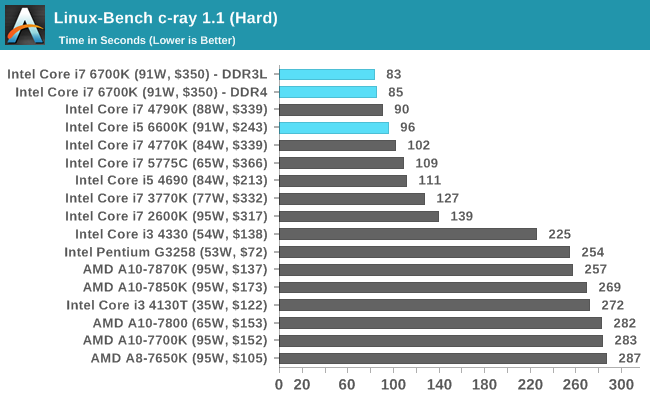
NAMD, Scalable Molecular Dynamics: link
Developed by the Theoretical and Computational Biophysics Group at the University of Illinois at Urbana-Champaign, NAMD is a set of parallel molecular dynamics codes for extreme parallelization up to and beyond 200,000 cores. The reference paper detailing NAMD has over 4000 citations, and our testing runs a small simulation where the calculation steps per unit time is the output vector.
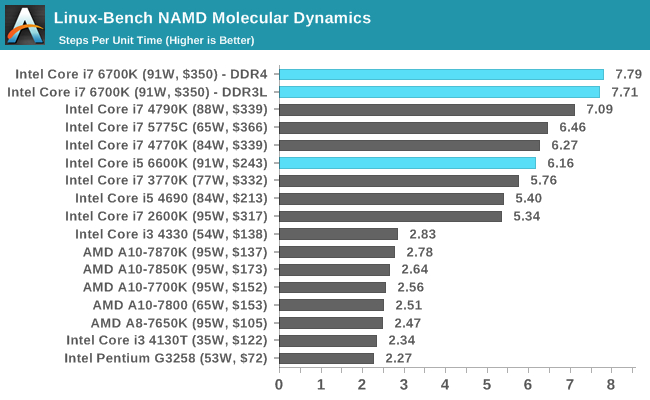
NPB, Fluid Dynamics: link
Aside from LINPACK, there are many other ways to benchmark supercomputers in terms of how effective they are for various types of mathematical processes. The NAS Parallel Benchmarks (NPB) are a set of small programs originally designed for NASA to test their supercomputers in terms of fluid dynamics simulations, useful for airflow reactions and design.
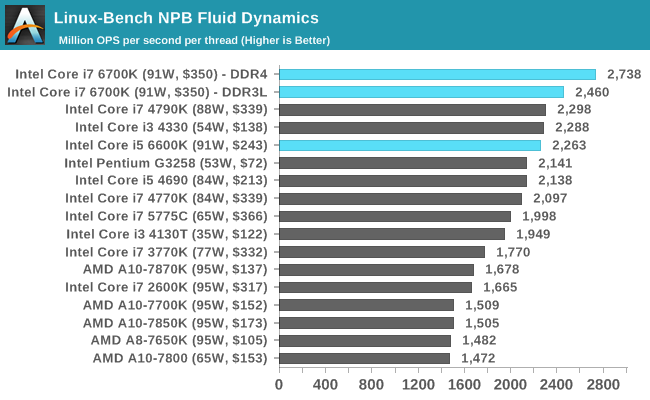
Redis: link
Many of the online applications rely on key-value caches and data structure servers to operate. Redis is an open-source, scalable web technology with a b developer base, but also relies heavily on memory bandwidth as well as CPU performance.
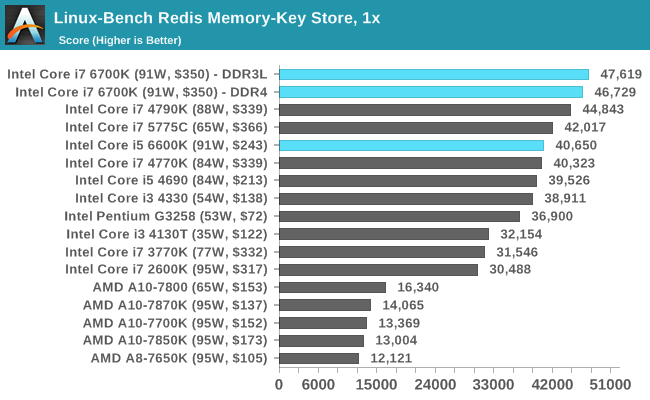
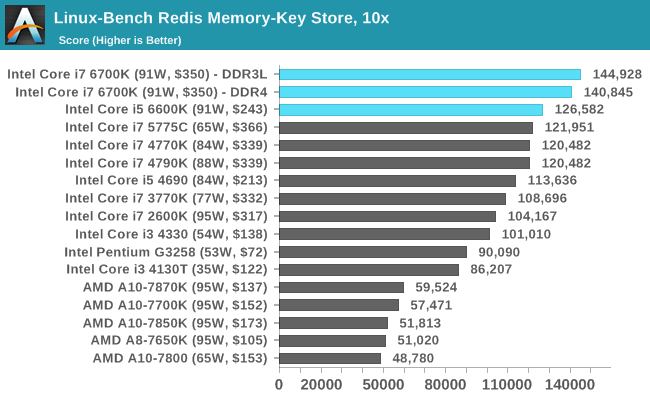
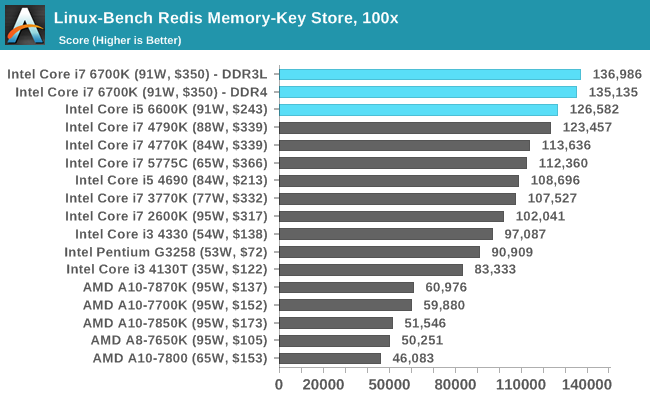










477 Comments
View All Comments
Jaguar36 - Wednesday, August 5, 2015 - link
I still don't see the point in upgrading from Sandybridge let alone anything newer. Its a big chunk of a cash for a new mobo, CPU and memory, all for what, 25%?Cumulus7 - Wednesday, August 5, 2015 - link
Exactly.Usually i suggest an upgrade if you get approximately twice the performance (+100%). But for 25%: forget it! Never!!!
colonelclaw - Wednesday, August 5, 2015 - link
The other way of looking at it is that it's amazing how good the Sandy Bridge numbers hold up, that good ol' 2600k is one of Intel's all-time great CPUs. Be happy you backed a winner!mrcaffeinex - Wednesday, August 5, 2015 - link
I did and I am very happy. It frees up funds to focus on other parts that make a bigger impact like more RAM, a larger SSD, and of course a better video card.This is better than Haswell in several ways and I imagine the overclockers are going to have some fun since they have been given back more options than some of the previous generations. At least it looks like Intel is paying more attention to the enthusiasts this time around, even if they are not the largest target market.
Cellar Door - Thursday, August 6, 2015 - link
Well, I'm glad I held back on the 2600K and 3770K and got haswell!! - So with this kind of reasoning, its a never ending circle.Look at the platform overall, the pcix storage, nvme compatibility, m.2 ports. USB 3.1 which will be all over the place a lot faster then people realize.
At the same speed its 37% faster and "In specific tests, it is even higher" - a good clocking 6700K will be a nice upgrade for anyone with Sandy. Just like Haswell was for Nahelem users.
Seems a perfectly justifiable upgrade.
Kutark - Sunday, August 9, 2015 - link
Eh. I've been wanting an excuse to upgrade from my 2600k. I am an "enthusiast" and building PC's and such is my hobby. So, it's not always just simply the price/perf value proposition. Christmas is coming up and my nephew doesn't have his own PC yet, and also loves to play steam games (he usually does it at his grandparents). So, this gives me an excuse to build a new setup. I still have my GTX 760 laying around that i upgraded to a 980ti. So a 6700k setup would be a nice pairing with the 980ti and should realistically set me for 3-4 years.kmmatney - Wednesday, August 5, 2015 - link
I'm an i5 3570K owner. If I'm going to upgrade, I'd look for an i7-4790K (or even a i7 2600K) on Ebay before completely overhauling my system with this.darkfalz - Wednesday, August 5, 2015 - link
Even that's a waste of money unless you are doing a tonne of Handbrake.mapesdhs - Wednesday, August 12, 2015 - link
No, get a 2700K instead, they oc much better than the 2600K.2700K = 5GHz guaranteed, even with a simple TRUE and one fan (I use the ASUS M4E,
built five so far).
tim851 - Wednesday, August 5, 2015 - link
Agreed. Especially when you factor in that those 25% is peak performance. How often does the average user call on peak performance? I think the most common and frequent scenario for average users to need CPU power is gaming. And here, due to the fact that GPUs are the bottleneck, you won't even get 10%.From an enthusiast point of view, the last 4 years since Sandy Bridge have been disappointing. If not outright worrying.